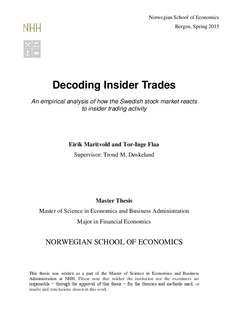| dc.description.abstract | In our study we explore and analyze 6 627 insider trades made on the NASDAQ OMX
Stockholm between 2010 and 2014. We ask if publicly available information on insider
trading can give insight into where stock prices will head in the future and if outside
investors can earn abnormal returns by creating portfolios based on such information. We
conduct our research using the event-study methodology as described by MacKinlay (1997)
and show that insiders are better informed about the overall future performance of their
company, indicating a violation of the semi-strong form market efficiency hypothesis. We
show that different firm characteristics such as market capitalization, financial leverage and
industry, together with individual characteristics such as insider type and traded volume, can
emphasize differences in abnormal returns following insider trades. Based on our findings
we create three rule-based insider portfolios. We show that we are able to gain risk-adjusted
returns above the market, but when controlling for transaction costs the risk-adjusted return
vanish. Our study has implications for market efficiency and offers important insights for
those who seek to earn higher returns by following strategies based on the publication of
insider trades. | nb_NO |
